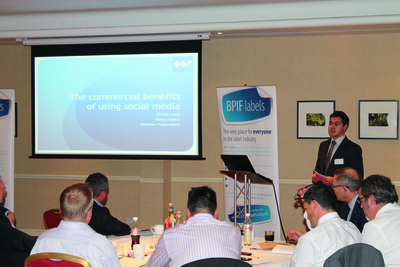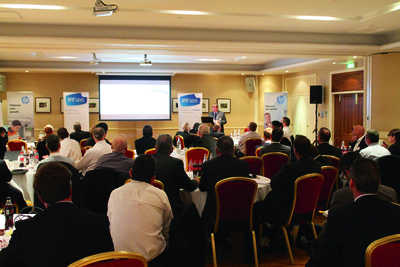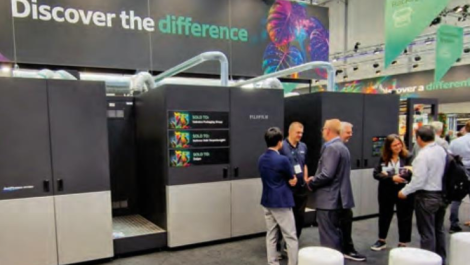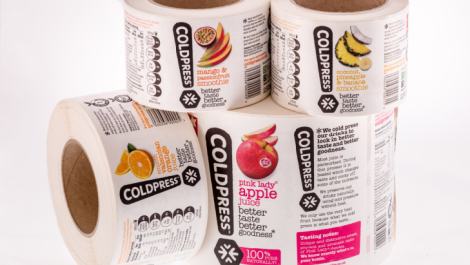Delegates gathered to learn about a range of topics dominant in the label industry
‘Digital label printing goes mainstream’ was the title of the BPIF labels seminar held in October, where nearly 60 delegates gathered to learn about a range of topics dominant in the label industry. By Michal Lodej.
Held over two days at the Forest of Arden Hotel, Birmingham, the HP sponsored event included a networking golf tournament, dinner and a whole day of presentations ranging from printing workflow systems to social media strategies.
The seminar began with a keynote address from Matthew Daniels, global capability leader for printing and decoration, Unilever, who gave a background to the company and outlined some of its plans for the future.
Mr Daniels said, ‘Late product differentiation, agility and flexibility, competitive pricing for low runs, fast changeovers and brand security, are all reasons that we are looking into using digital. We want to manage its complexity and to use it as a marketing tool.’
Unilever is currently only using digital for producing mock ups, but the intention is to put digital printing into all its main sites as it sees an opportunity to be able to respond to the demands from all the big retailers.
Details of digital
Presentations from suppliers, including AB Graphics, Avery Dennison, AVT, Esko, HP Indigo, Domino and Intec Printing Solutions, detailed how their products can help printers move into digital.
David Harris, Esko, described the market drivers and how digital can help create value for the customer. He emphasised the importance of eliminating bottlenecks in administration, pre-press and finishing to keep up with production, and said, ‘When you want digital printing capabilities, buying a digital press isn’t the end of the story. Workflow automation is key; making as much of the workflow automated as possible willincrease productivity.’
Speaking about the use of digital in packaging, Mr Harris went on to say how digital printing can produce product variations, such as limited editions, making the product stand out on the shelf.
Andrew Knowles, sales manager UK and Ireland, HP Indigo, spoke of the direction the company is going to take in the coming years, which includes moving into flexible packaging and cartonboard, as well as improving its colour management. This will mean the development of new machinery to facilitate these substrates, however, Mr Knowles said, ‘We will retrofit any press developments where possible. We believe it is important to support the pioneers of this industry.’
Stephen Hancock from Domino spoke about digital printing in the industry today. He said, ‘There is a strong level of competition in this industry which we take as a good sign. The speed of digital presses now available on the market is getting faster with print quality getting better.’ Speaking about getting the best quality from digital printing, Mr Hancock said, ‘It’s all about how the press integrates around the printheads.’
Representing a low cost alternative in digital printing was Mark Baker- Homes, business development director, from Intec Printing Solutions. He asked, ‘Digital printing might be the answer for your company but how do you get into it?’
His solution was to go for a low cost printer, such as the Intec Edge 850, which can print at speeds of up to 9.14 m/min and uses dry toner technology. The machine runs with a Harlequin RIP and has no moving parts, making it very reliable.
Peter Juxson from AVT presented the company’s automatic inspection systems. He said that by finding defects before it is too late can help to save waste, time and labour, ‘Process control automation allows the printer to get on with the printing.’
Matthew Burton from AB Graphics spoke about the advantages of integrating automated finishing workflows to accommodate inline digital finishing, and David Torley, technical sales manager, Avery Dennison, gave a presentation on the choice of raw materials for digital printing, looking at different substrates.
Experiences shared
Case studies were presented by printers sharing their experiences of digital printing. Trevor Smith, managing director, Amberley Labels, spoke about new markets for digital labels and the company’s involvement with the recent Coca-Cola personalised bottles campaign.
In his presentation Mr Smith spoke about how digital printing does not always have to stay in the mould it has been given. He said, ‘When people speak about digital printing they often say it fits perfectly with short run work, but the Coca-Cola project was not a short run project in the slightest.’
The challenges faced during the project included printing on unsupportive film and maintaining the ‘Coca-Cola’ red. Mr Smith also spoke of the dangers of this type of job, saying, ‘The company has to be careful it is not typecast as a ‘personalisation only’ company.’ He went on to add that the campaign was not ‘on demand printing’, another attribute associated with digital printing. ‘Digital is only good for on demand printing if you have an on demand business,’ Mr Smith concluded.
Another case study from Ian Lemon, owner of Springfield Solutions, explained how his company moved away from conventional printing. He compared the industry to a battlefield, with flexography on one side and digital on the other, however, his own view is that both technologies have a place in the market and both should be used when appropriate.
Mr Springfield said, ‘I don’t like being called a digital printer, that is a far too simplistic way of describing what we are trying to achieve’. He stressed that the company only moved away from conventional printing because it was right for them at the time and that by no means does he expect everyone to move to digital. He said, ‘It was an evolution not a revolution to digital printing and it was certainly not an easy decision to make. But now we can’t compete with long runs so instead we focus on what we can be excellent at.’
He concluded, ‘It is not enough to just be a printer. Adding value to increase your margins is where the money is. Remember to start talking about what your customers want before looking at the technology you should use.’
 Michal Lodej gave a presentation on social media
Michal Lodej gave a presentation on social media
More than printing
Other presentations were held to help printers in areas other than the printing side of the business. Phil Dalton, head of regulatory at Legal Impackt, a company which is one of five brands under the ownership of SCN Branding Solutions, spoke about implementing food labelling requirements.
Part of his company’s role is to approve packaging artwork to make sure it complies with mandatory information and he informed attendees about the first major changes in food labelling since the 1980s, which he said will require every food label to change. His presentation outlined the difficulties label designers will face whenthe EU changes the regulations dictating how nutritional information is displayed on food packaging.
Mr Dalton said, ‘It is nutritional information which will be compulsory and if it is not on the package it will have to be added. Alternatively if it is already on, it will have to be changed; either way there will be a change to the packaging.’
The legibility of written information will be enforced and will need to be displayed on the front of the packaging and at a certain size. The size of the font will be determined by the size of the packaging.
There is, however, a conflict of interest between these new regulations and those from a 2003 EU directive that states that companies must endeavour to use the smallest amount of packaging as possible.
A presentation from Michal Lodej, Whitmar Publications’ online editor, explained the commercial benefits of social media. He outlined how printers could raise awareness about their company and its capabilities through social media, and potentially gain new customers.
The seminar concluded with an industry focus delivered by Mike Fairley, whose presentation looked into how digital is impacting the labels and packaging industry, starting from when the first digital presses where introduced in the early 1990s.
The seminar helped to convey that although digital is now becoming an established technology in the label printing industry, companies adopting it still need to have a concrete strategy for its use. A great deal of thought should be given to using digital, it has many strengths, but it is also important to recognise its limitations.
Should all label converters invest in digital capabilities? The answer remains the same for all printers. What do your customers want?






